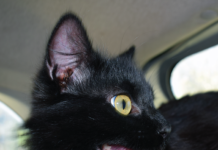Fighting Feline Fungal Infections
Take a deep breath before reading this list of infections that can cause upper respiratory disease in cats: Feline herpesvirus-1, feline calicivirus, and Chlamydophila felis have long been known to infect cats upper respiratory tracts.
Bacterial infections more recently implicated as respiratory pathogens include Bordatella bronchiseptica and Mycoplasma, according to the journal, Veterinary Medicine (March 2003). Too often overlooked is a host of fungal infections, say article authors from Oklahomas College of Veterinary Medicine. If cats could read Latin, these names would crimp their whiskers: Cryptococcus neoformans is a yeast while Blastomyces dermatitidis, Histoplasma capsulatum and Coccidioides immitis are three of the so-called dimorphic fungi, the ones that can assume two forms. And systemic mycosis is what happens to a cat when a fungus fiddles with its systems.
Cryptococcocis is the most common systemic mycosis in cats, the journal reports, and also the most devastating. Found in soil or buildings contaminated with bird droppings, the fungus is inhaled with dust into the lungs, and then spreads through the blood or lymphatics to other parts of the cats body.
Not quite as bad or widespread (only in the Mississippi, Missouri, and Ohio river valleys, mid-Atlantic states, and southern Canada) is blastomycosis. Histoplasmosis comes from the same general area, in bat excrement as well as birds. Coccidioidomycosis is generally rare – occurring in some areas of the Southwest, Central, and South America.
The best way to avoid fungal infections in cats, the journal says, is to keep them indoors. You may exhale now.
Amitriptyline Fails Its Urine Test
In the scientific category of It-seemed-like-a-good-idea-at-the-time, treating lower urinary tract disease (LUTD) in cats with the drug amitripytyline was initially appealing.
Idiopathic – medical jargon for we really dont know what causes it – LUTD is the most common cause of cats urinating in inappropriate places. And more than 30 pharmaceutical agents or procedures have been recommended to manage idiopathic LUTD, according to the Journal of the American Veterinary Medical Association (Vol. 333, No. 6). But few proposed treatments had been evaluated in scientifically controlled tests, said journal authors from the Michigan State Universitys College of Veterinary Medicine. So they focused on amitriptyline (sometimes called Elavil).
One of the tricyclic antidepressants, amitriptyline has been used extensively to treat human patients with interstitial cystitis, the veterinary researchers noted. Chronic idiopathic LUTD is also characterized by urinary urgency and frequency – which might prompt people to urinate in inappropriate places, too, if they were as uninhibited as cats. It had even been tested in rodents and cats, where it seemed to block uptake of the brain chemicals serotonin and norepinephrine. So far, so good.
Thirty-one cats with LUTD volunteered for the study, probably at the urging of their owners. Sixteen got the amitriptyline, and 10 controls got a placebo. After only eight days, the LUTD had cleared up in eight of the amitriptyline-treated cats – and in all 10 control cats on that miracle drug, placebo. However, clinical signs of LUTD recurred significantly faster and more frequently in amitriptyline-treated cats than in the control cats.



